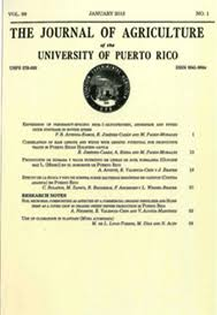Abstract
Sweet chili pepper (Capsicum chinense Jacq.) is an important part of the local cuisine of Puerto Rico where it is known as ají dulce. Considering opportunities for vegetable production in Puerto Rico, soilless alternatives for production of sweet chili pepper should be considered. This study evaluated five substrates: (1) PRO-MIX® BX (BX); (2) PRO-MIX® BX + Mycorrhizae (BX+Myco); (3) PRO-MIX® High porosity + Mycorrhizae (HP+Myco); (4) PRO-MIX® High porosity + Mycorrhizae + Biofungicide (HP+Myco+Fung); and (5) coconut coir. Four experimental lines of sweet chili pepper (G-2, Sel-7, G-11 and G-8, to be released as ‘Amanecer’, ‘Bonanza’, ‘Carnaval’, and ‘Pasión’, respectively) were tested with each substrate. Two outdoor plantings in containers were carried out with a factorial combination of four lines by five substrates: Trial 1 from March to September 2017 and Trial 2 from October 2017 to April 2018. In addition, the four experimental lines were transplanted to the field (Field Control Trial). All plantings took place in Mayagüez, Puerto Rico. Differences among substrates were relatively consistent in Trial 1 and Trial 2. Sweet chili pepper in BX+Myco and HP+Myco+Fung flowered 50.3 days after transplanting (DAT) while plants in coconut coir flowered about two and a half weeks later. There were few or no differences in BX, BX+Myco and HP+Myco+Fung for plant height, number of fruit and total fruit weight. Plants grown in HP+Myco and coconut coir were shorter, with fewer fruits and lower fruit weight. Average fruit weight was similar among all substrates. Relative differences among lines in the three trials were less consistent than for substrates. Line G-11 was the earliest flowering line at 50.1 DAT as well as the shortest line. The other lines flowered eight to 10 days later. The tallest line varied from trial to trial. Line Sel-7 produced the greatest number of fruits per plant in Trial 1 and in the Field Trial, while G-2 and G-8 produced the greatest number in Trial 2. Line Sel-7 had the highest total fruit weight per plant in Trial 1 and in the Field Trial while G-2 had the greatest total weight in Trial 2. Despite the high number of fruits in plants of G-8, yields were 60% less because of small average fruit weight. Line Sel-7 had the greatest average fruit weight in Trial 1 while G-11 had the highest fruit weight in Trial 2. This research suggests that, based on its lower cost, BX would be a good choice for soilless production of sweet chili pepper. For production in containers, sweet chili pepper lines G-2 and Sel-7 showed better performance than G-8 and G-11.

